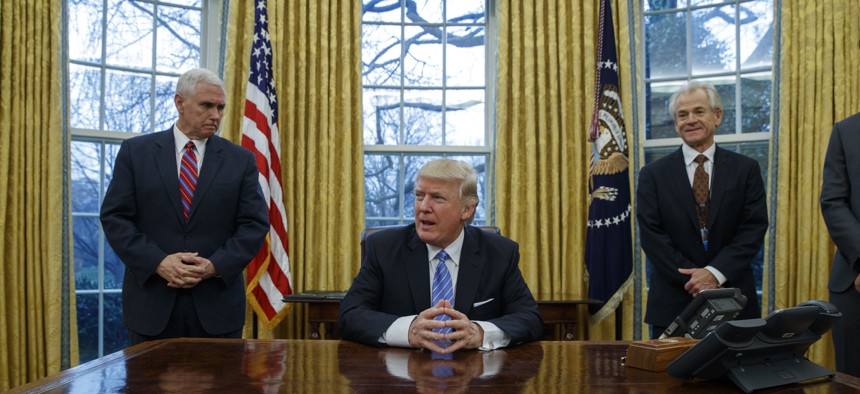
Vice President Mike Pence, left, and National Trade Council adviser Peter Navarro, right, wait for President Donald Trump to sign three executive orders, Monday, Jan. 23, 2017, in the Oval Office of the White House in Washington. Evan Vucci/AP
Trump’s First Budget Could Be A Unique Mix of Severe Cuts and Increased Spending
New presidents typically unveil a broad budget plan in February, and a more detailed version in the spring.
Now that President Donald J. Trump has been sworn in as the 45th commander-in-chief, his next major task is unveiling a fiscal 2018 budget proposal for federal agencies that reflects his America First vision for the government.
Crafting a budget proposal for Congress to review and debate is always a top priority for the president, especially a new one. Trump’s inaugural budget will be the first look federal employees, lawmakers, and the rest of us get at the president’s detailed agenda and how he plans to pay for it.
“There is no 2018 template sitting there for the new administration,” said Ed DeSeve, co-chair of the National Academy of Public Administration's Transition 2016 Program. DeSeve is a veteran of presidential transitions and has served at the Housing and Urban Development Department as well as the Office of Management and Budget. Trump, DeSeve said, has a challenge ahead of him, “especially given the fact that he doesn’t have experienced hands.”
Trump’s nominee for Office of Management and Budget Director is Rep. Mick Mulvaney, R-S.C., who serves on the House Financial Services Committee and the House Oversight and Government Reform Committee. As a lawmaker, he has been vocal about budget issues, especially cutting spending and balancing the budget.
Mulvaney, said DeSeve, “has legislative branch experience, but it’s different putting a budget together than it is taking a budget apart.” DeSeve said that “the OMB career staff is fabulous at this” and “are very well organized.” But the career employees have “to get direction, and they have to be given a sense of how the budget is going to be assembled,” DeSeve added. “So it’s a big challenge in front of the new OMB director and the president.”
New presidents typically unveil a broad outline of their first budget in mid-to-late February, and then the official, detailed proposal that goes to Congress in the spring. Former President Obama released his broad fiscal 2010 budget proposal on Feb. 26, 2009, and the detailed plan on May 7 of that year. Obama’s first budget laid out his plans to reform health care, provide some tax breaks for the middle class, reduce the deficit, and pursue renewable energy, among other items.
Trump has talked about implementing a hiring freeze across government as well as eliminating waste in agencies, so his budget proposal could reflect those priorities. The Hill last week reported that the Trump administration is backing a budget plan that would eliminate entire agencies and a number of federal programs. But the new president also has promised to invest in other areas, like infrastructure, increasing the size of the military, and expanding border control activities. All of those things will call for more spending, and are likely to make their way into his budget blueprint. The White House web site on Friday reflected the new administration’s priorities; the URL for the OMB site, however, appeared to be broken.
Trump is planning “a point-by point departure, the Uberization of the federal government,” in which every department chief financial officer goes through the agency books to determine spending, said Republican lobbyist David Urban, a Trump transition team member and Pennsylvania political operative, during a Friday Politico event in Washington. Urban said that Trump is involved “at the granular level.” He also acknowledged that “Trumpism will run into some bumps with the $1 trillion infrastructure plan that some Republicans don’t like.”
For federal agencies, however, there is still most of fiscal 2017 to get through. “One of the things that makes this transition a little challenging is that everyone is still operating under the continuing resolutions, so there is limited information about resources that are available,” said NAPA President Terry Gerton. “You are going to have a lot of folks who are trying to figure out and provide input at a time when the spending plans are still temporary. It’s a pretty tricky time from a resource perspective,” Gerton said.
The current CR, which Congress passed in December, keeps the government funded through April 28. That’s right around the time that Trump likely will release his detailed budget plan for fiscal 2018. DeSeve said he would “bet for a full-year CR” after the short-term measure expires, with Congress passing some appropriations for specific departments, like Defense. “If you are HUD or DOT [Transportation], I think you are looking at a CR,” unless Trump opts “to do his infrastructure program starting in ’17, and not waiting until ’18.” If that were the case, the president would have to press for specific legislation related to that. “It would be a new program, and set of accounts,” said DeSeve.
Charles S. Clark contributed to this story.
NEXT STORY: One Last Trip With Joe Biden




